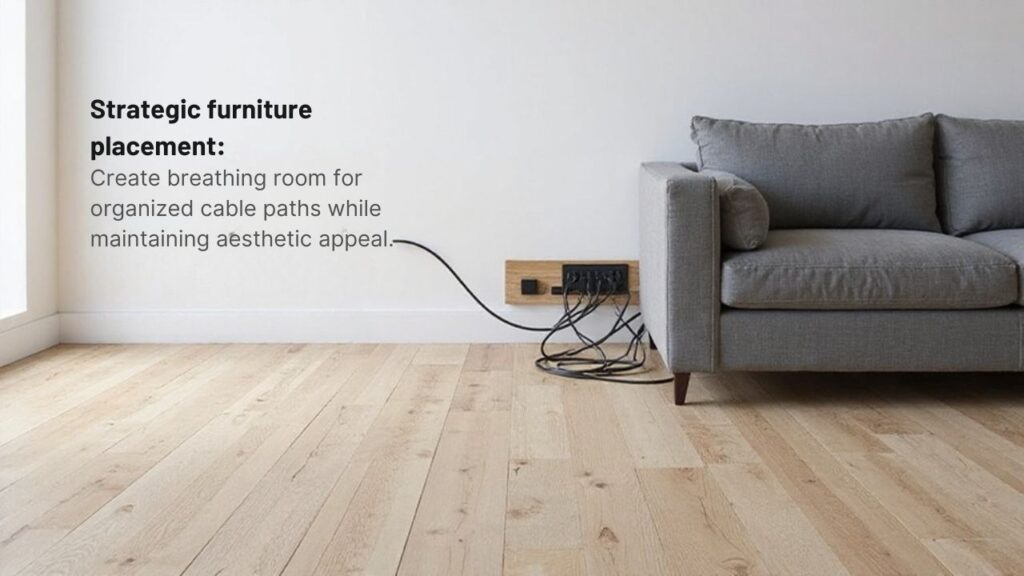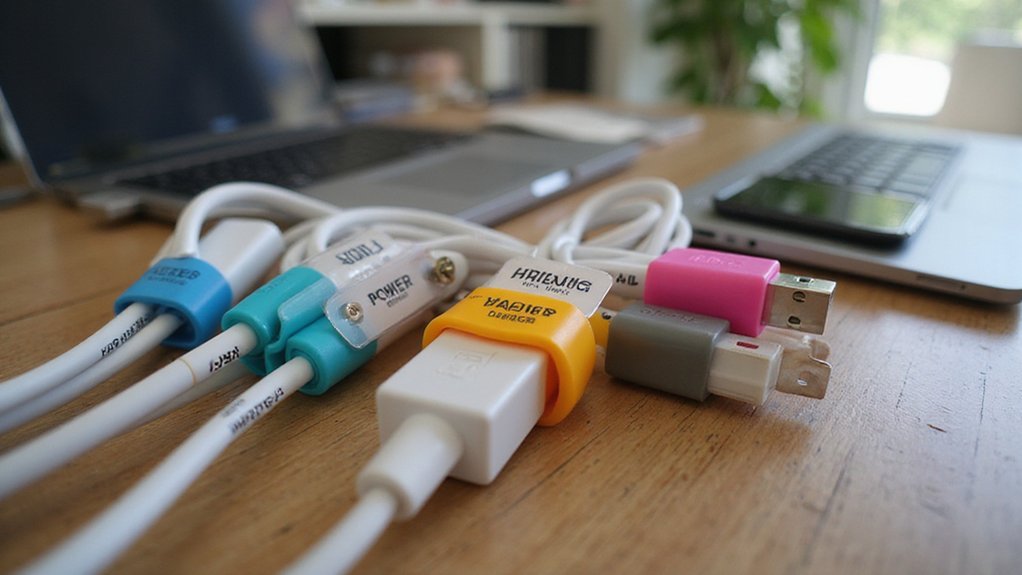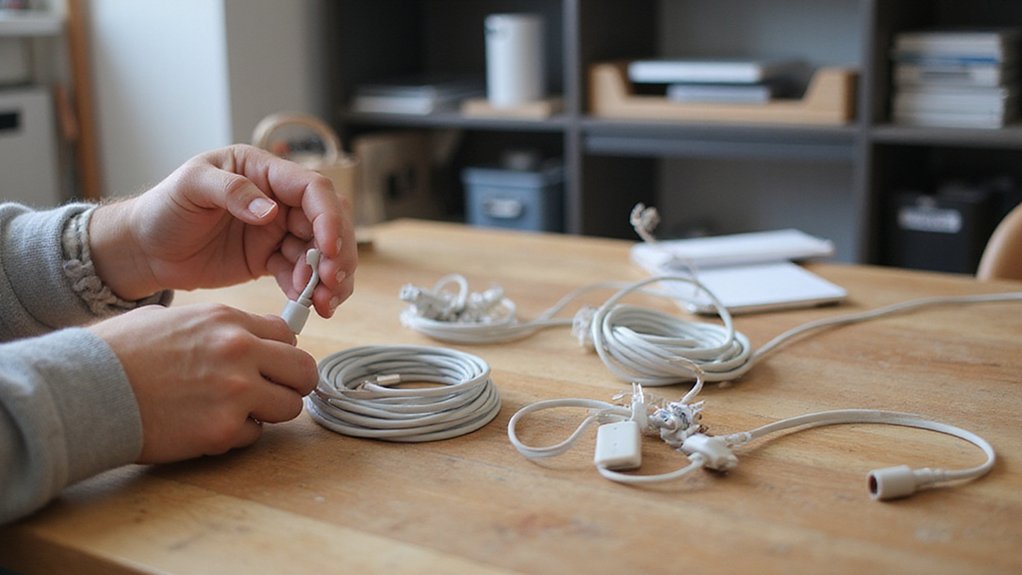Tangled Cords can be a Pain!
Tangled cords create both visual chaos and functional problems in your home. You’ve likely experienced the frustration of searching for the right cable among a knotted mess or tripping over exposed wires. Fixes for tangled cords based on simple organization strategies can transform these troublesome tangles into neat, accessible systems. You can do this without requiring significant time or money.
The solutions range from five-minute fixes to extensive systems that’ll keep your technology connected while maintaining your space’s aesthetic appeal. What’s even better? You can start today with items you already own.
Key Takeaways
- Use binder clips on desk edges to secure cords and prevent immediate tangles.
- Work methodically to detangle by segmenting cables into small groups and separating loops with your fingers.
- Secure cords after detangling with color-coded Velcro wraps or reusable ties for easy identification.
- Convert shoeboxes into cable management boxes with labeled slots for different device cords.
- Install adhesive cable clips along walls and furniture to route cords safely and prevent future tangles.
Identifying Problem Areas for Cord Management
Where should you begin when tackling cord management challenges? Start by evaluating high-traffic areas in your home where cables create common clutter and safety concerns. Hallways, home offices, and entertainment centers typically harbor the most dangerous cord configurations.
Unlike wet floors with visible warning signs, loose cables often escape notice until it’s too late—even a single extension cord poses significant risk.
Examine your workspace for warning signs: tangled cables restricting airflow around equipment, cords stretched across walkways, or areas where disconnections frequently occur. Implementing color coding systems for different cables can dramatically improve troubleshooting efficiency and maintenance. Consider installing under-desk mounts to keep cords organized and out of sight, significantly reducing workspace clutter. Measure the distances between your equipment and available outlets to determine if you need proper cable lengths rather than risky extensions.
Cluttered cables create both technical hazards and physical dangers—identify these problem spots before they identify you.
Pay special attention to spots where maintenance becomes difficult due to cable congestion. Remember that 15-25% of workplace injuries stem from slips, trips, and falls, with loose cables being a primary culprit.
Identifying these problem zones is your first step toward creating a safer, more efficient environment.
Quick DIY Solutions for Instant Cable Organization

You’ll find immediate relief from cord chaos by using household items like binder clips on desk edges and colored thread for wrapping cables.
Transform shoeboxes into cable management boxes with labeled slots for different devices, or install under-desk wire baskets to keep power strips and adapters off the floor.
These five-minute fixes require minimal investment while delivering maximum organization, especially when you bundle excess cable length with reusable ties or repurposed materials. Attaching cables to your walls using adhesive cable clips can eliminate tripping hazards while maintaining a clean aesthetic. For advanced organization, consider using 3D printed components that can be customized to fit specific desk setups and cable needs.
Five-Minute Cord Detangling
Tackling a jumbled mess of cords doesn’t require an entire afternoon—just five minutes and the right approach can transform chaos into order. Start by segmenting your cable types into small groups and lightly moistening them with a damp cloth to reduce static cling. Similar to how DIY hair detangler works on knotted hair, this simple moisture technique helps cords slide past each other more easily.
Work methodically from one end, using your fingers to separate loops before employing detangling methods like gentle pulling. Never tug sharply—this damages connections and tightens knots further. Consistent detangling maintenance prevents cord messes from becoming completely unmanageable over time.
| Detangling Phase | Tools Needed | Time Allocation |
|---|---|---|
| Initial Sorting | Clips/Twist ties | 1 minute |
| Moisture Application | Damp microfiber cloth | 30 seconds |
| Knot Loosening | Wide-tooth cable comb | 2 minutes |
| Final Organization | Velcro wraps/Labels | 1.5 minutes |
After untangling, immediately secure cords with reusable Velcro wraps and label each by function to prevent future tangles.
Budget-Friendly Wire Solutions
While professional cable management systems can be costly, creating an organized cable setup doesn’t require expensive equipment or specialized tools. You can achieve impressive results through creative repurposing of everyday items and sustainable materials already in your home.
- Transform household items – Repurpose binder clips on desk edges to hold cables, or use bread clips and toilet paper tubes to separate and identify different cords.
- Implement adhesive solutions – Attach double-sided hooks or $10 cable clips along furniture edges to route wires discreetly. The strong adhesive clips available in Amazon kits can effectively support heavier cables under your desk.
- Bundle strategically – Group cables by device using $5 zip ties or reusable Velcro straps for flexibility. This approach complements the space efficiency benefits that compact workstations like mini PCs offer in home office environments. Regularly evaluate your cable organization to ensure accessibility without clutter as your setup evolves.
- Create DIY channels – Fashion cable pathways from cardboard strips or fabric sleeves to combine multiple wires into neat bundles. Proper cable organization can prevent workspace distractions that reduce productivity and mental focus.
Budget-Friendly Cable Management Products

You’ll find plenty of low-cost bundling solutions like zip ties and adhesive strips starting at just $5 for basic cable management needs.
Consider trying DIY organization hacks such as repurposing toilet paper tubes or using binder clips to keep your cords neat without spending a dime.
When shopping for budget-friendly options, compare Walmart’s multi-product kits around $15 with Dollar Store alternatives that often provide similar functionality at a fraction of the cost.
For a stylish and practical solution, the IKEA SÄTTING Cable management box with lid offers excellent value at $7.99 while helping reduce visual clutter in your home.
For professional-grade quality without breaking the bank, explore options from top manufacturers like Ideal, Panduit, and Legrand that CableOrganizer.com has been offering since 2002.
Low-Cost Bundling Solutions
Managing cord tangles doesn’t have to break the bank, as numerous affordable bundling solutions exist for every budget.
The market offers practical options that combine functionality with eco-friendly options and creative storage approaches.
Consider these cost-effective cable management tools:
- Velcro strips provide reusable bundling power, allowing you to adjust as your setup evolves while reducing plastic waste.
- Twist ties offer quick fixes for smaller cable groupings—repurpose those that come with other products for zero-cost solutions.
- Cable turtles and fish elegantly wind excess cord length while adding a decorative element to your space.
- Basic cable management kits deliver thorough solutions with various clips, ties, and sleeves to address multiple organizing challenges at once.
3M Command Adhesive Hooks provide a damage-free option for routing cables along walls, holding up to five pounds without leaving residue when removed.
For a more permanent solution, products like the QiaoYoubang offer easy installation options using double-sided tape or screws depending on your preference.
DIY Organization Hacks
Beyond store-bought solutions, DIY cable management offers a perfect balance of affordability and customization for taming cord chaos. With starter kits under $20, you’ll access versatile components—clips, ties, and sleeves—that mount without tools and accommodate various wire gauges.
For extensive organization, consider flexible trays that bend to fit your specific desk configuration. These rigid options safely house power strips while maintaining accessibility. The economical plastic hangers solution provides sturdy black material perfect for everyday cable organization.
When excess cord length creates visual clutter, implement winding solutions like Cable Turtles that snap open and closed for quick adjustments.
Self-adhesive clips with removable adhesive provide instant routing without damaging surfaces—perfect for renters. This approach can save up to 75% less space compared to traditional cable management systems, similar to the space efficiency benefits of mini PCs in office environments.
The true advantage of DIY cable solutions lies in expandability; start with basic clips and gradually incorporate creative cord storage elements as your needs evolve, mixing colors and materials to complement your décor.
Walmart vs. Dollar Store
When comparing budget options for cable management solutions, Walmart and dollar stores represent two distinct approaches that cater to different organizational needs.
Walmart’s selection spans from $6.29 basic organizers to extensive $89.99 systems, while dollar store affordability remains fixed at $1 per item.
Consider these factors when choosing between retailers:
- Product Range – Walmart offers magnetic clips, cord organizers, and extension cord clips versus dollar stores’ basic ties and simple clips.
- Shopping Experience – Walmart provides both online and in-store shopping; dollar stores typically require in-person visits.
- Quality Spectrum – Walmart stocks varied quality levels across multiple brands; dollar stores feature primarily generic options. Walmart’s inventory includes premium options like the Were It magnetic organizers in both black and white color variants.
- Review Availability – Walmart products include customer feedback to guide your purchase; dollar store items rarely have documented reviews. The onn. Cable Clips with 3273.9 star ratings demonstrate the value of having access to extensive customer feedback.
Strategic Furniture Placement for Hidden Cord Routing

Strategic furniture placement serves as the foundation for effective cord management in any space. Your furniture arrangement directly impacts how easily you’ll conceal cables while maintaining accessibility for maintenance and device use. Position desks and cabinets near power outlets to minimize visible cord runs, and cluster electronic devices on surfaces with built-in routing features. This approach creates a professional appearance that reflects positively on your commitment to organization and attention to detail. Using high-quality cable ties can help bundle and organize cables to prevent tangles known as cable spaghetti. Choosing furniture with ergonomic design benefits both cord management and user comfort during long hours of work. Consider using wireless peripherals to significantly reduce desk clutter while maintaining an efficient workspace.
| Placement Strategy | Cable Concealment Benefit | Maintenance Consideration |
|---|---|---|
| Wall-adjacent positioning | Hides cords behind furniture | Allows easy access to outlets |
| Perimeter arrangement | Creates natural pathways | Minimizes floor hazards |
| Clustered electronics | Centralizes cable management | Simplifies troubleshooting |
| Corner configurations | Maximizes hidden routing options | Requires planning for airflow |
When planning your layout, verify furniture doesn’t obstruct cooling vents or air circulation paths, and leave sufficient gaps for accessing cables when needed. This approach prevents overheating while maintaining an organized appearance.
Wireless Alternatives to Reduce Cable Clutter

While strategic furniture placement helps conceal existing cables, eliminating cords altogether offers an even more effective solution.
Embracing wireless technology creates a cleaner aesthetic and reduces trip hazards in your home.
Transform your space with these cable-free innovations:
- Bluetooth technology powers wireless speakers and headphones, instantly removing audio cords from your entertainment setup.
- Smart devices centralize control through Wi-Fi enhancements like Wi-Fi 6, supporting more connections with fewer physical wires.
- Wireless charging pads and furniture-integrated solutions eliminate daily plug-in requirements for compatible devices.
- Cable-free furniture with built-in charging capabilities, like nightstands with Qi-charging surfaces or lamps with USB ports, combines functionality with clean design.
Modern rechargeable wireless devices offer convenience while contributing to a tidier space and eliminating the need for constant cord management.
For office environments, mini PCs like the Blackview MP80 provide powerful computing in a compact form factor while reducing cable clutter.
Mini PCs are exceptionally energy efficient compared to traditional desktops, helping to lower utility costs while maintaining performance.
For areas where wireless solutions aren’t feasible, carpet runners provide an elegant way to hide necessary cables while adding decorative elements to your living space.
Color-Coding and Labeling Systems for Easy Identification

Looking beyond the tangle of cords in your home, a well-implemented color-coding system creates instant visual organization that saves time and reduces frustration.
Assign specific colors to each cable category—blue for speakers, green for A/V, and different shades for chargers. Using an ultra fine marker on cable IDs provides exceptional clarity when identifying your connections. Attach durable color-coded labels to both ends of cords, incorporating glow-in-the-dark options for low-light accessibility. This enhances cable visibility while reducing cognitive load.
Store cables in matching color-coded containers, using complementary ties and clips to maintain the system. Color psychology plays an essential role here—red can designate priority cables requiring frequent access, while cooler tones work for less-used connections.
This systematic approach not only streamlines identification but promotes safety by preventing accidental disconnections and encourages consistent maintenance habits as the visual system reinforces your organizational scheme.
Creating Dedicated Cable Stations in Different Rooms

Establishing dedicated cable stations throughout your home expands on color-coding principles by giving cords physical homes where they’re used most.
Focus on high-traffic areas where devices frequently need power or connectivity.
- Install in-drawer outlets in nightstands and bathroom vanities to charge devices while keeping surfaces clutter-free and maintaining a minimalist aesthetic.
- Mount under-desk cable trays to secure wires in one location, preventing accidental disconnections and creating a cleaner workspace.
- Create entertainment center solutions with integrated shelving that includes cable pass-through holes, allowing all wires to exit from a single point.
- Designate modular stations in each room using adjustable organizers that adapt to your evolving tech needs and enable quick reconfigurations without permanent changes.
Maintenance Routines to Prevent Future Tangling

Even the most elegantly organized cable system will eventually descend into chaos without regular maintenance routines. Schedule monthly cable inspections to identify wear, fraying, or damage—replacing problematic cables before they create hazards or disrupt your setup.
Implement a consistent cable labeling system using color-coded tags or heat-shrink labels to instantly identify each cord’s purpose. This eliminates the frustrating “unplugging roulette” when disconnecting devices.
Dedicate specific cable storage solutions for unused or seasonal cords—drawer organizers, labeled boxes, or wall-mounted hooks keep extras accessible yet organized.
When integrating new devices, immediately secure their cables into your existing management system.
Frequently Asked Questions
How Do Cable Management Solutions Affect Home Insurance Rates?
You’ll reduce insurance rates through proper cable organization. Insurers view your commitment to electrical safety favorably, potentially offering premium discounts when you mitigate fire hazards with innovative cable management solutions.
Can Improper Cable Management Cause Significant Power Bill Increases?
Yes, your cord clutter can increase power bills. Tangled cables create resistance and heat, reducing energy efficiency. Proper management prevents these inefficiencies and potentially saves you measurable money each month.
Are There Specific Cable Solutions for Homes With Pets?
Yes, you’ll find pet-friendly organizers and tangle-resistant cables specifically designed to prevent chewing damage. Use protective sleeves with bitter scents, elevated cable routes, and enclosed management systems for thorough pet protection.
How Often Should Cable Ties and Organizers Be Replaced?
Replace indoor cable ties every 1-2 years; outdoor ties every 6-12 months. You’ll need more frequent replacement when you notice cracking, brittleness, or discoloration affecting cable lifespan and organizer functionality.
Do Smart Homes Require Different Cable Management Approaches Than Traditional Homes?
Yes, your smart home demands more sophisticated cable organization strategies. You’ll need structured wiring centers, PoE considerations, and future-proofing for emerging smart technology to maintain an efficient, scalable system.
Conclusion
Whether you’re taming a snake pit of chargers near your nightstand or handling the cable jungle behind your entertainment center, these systematic approaches will reclaim your space. You’ll find that maintaining your new organizational system takes only minutes weekly, preventing the inevitable creep of cord chaos. By methodically implementing these solutions room by room, you’ve created not just order, but a precisely engineered home environment that functions at peak efficiency.

I am a retired software engineer with experience in a multitude of areas including managing AWS and VMWare development environments. I bought a relative a mini-PC a year ago and have become passionate about the technology and its potential to change how we deploy software.

